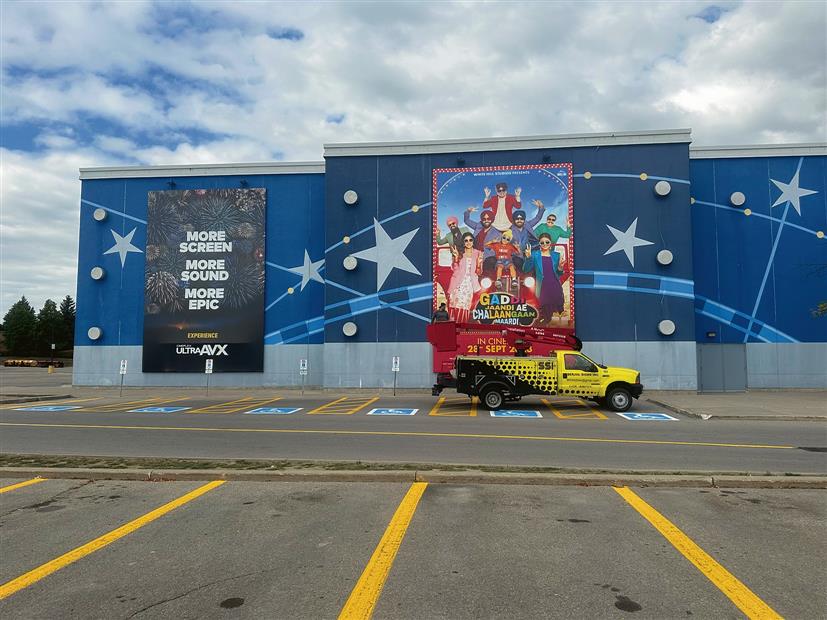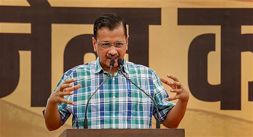
A hoarding displays the poster of Gaddi Jaandi Ae Chalaangaan Maardi' in Brampton, Canada. Photo courtesy: White hill studio
Nonika Singh
A SLICE of Sikh history extolling the community’s valour and sacrifices, Punjabi film ‘Mastaney’ has been a runaway hit. But in September, as it released in Seoul, South Korea, it made trade pundits sit up and take notice. Whatever happened? In times when cinema knows no language, did the Koreans — whose movies and shows Indians are loving right now — suddenly wake up to Punjabi language movies? The answer is not as heartening. Like always, the secret behind the magical box-office figures is once again the Punjabi diaspora.

Punjabi cinema has been capturing the overseas market for a long time. In a way, cinematographer-turned-filmmaker Manmohan Singh set the ball rolling with ‘Jee Aayan Nu’, as he broke the template. Prolific actor Gurpreet Ghuggi, also an integral part of ‘Mastaney’, reminds us, “Manmohanji showed us the other side of Punjab, far removed from the then prevalent gandase, ghode and daku. Viewers, especially abroad, were tickled pink. They hadn’t seen a Punjab with lavish farmhouses embellished with swimming pools and what not.”
While the novelty factor and Singh’s adept direction may have clicked in making ‘Jee Aayan Nu’ a worldwide hit, Munish Sahni, the distributor and producer of many a hit Punjabi movie, insists, “The earlier reach of Punjabi films can’t be compared with the recent trends, which have shown a remarkable upward graph.” In fact, the demand for ‘Mastaney’ emanated from Punjabis settled in Korea itself. The same can be said about its release in African nations such as Kenya. Clearly, the market is expanding both within traditional bases such as Canada and Australia, as also newer areas.

The collections from overseas markets are often bigger, says Deepa Rai, a UK-based film director, adding that an increased number of cities in the UK are showing Punjabi films today. Sharan Art, director of ‘Mastaney’, shares that for quite some time, the ratio of overseas market to domestic has been 60:40. While the release of ‘Mastaney’ in South Korea and Africa has grabbed eyeballs, the blockbuster ‘Carry on Jatta 3’ was released in 30 countries, and marked new territories, especially in Europe. In Spain, the film was shown with Spanish subtitles!
Jagmeet Samundri insists that the recent tidings, even if happy, are not to be read or seen in the same light as the success of Telugu blockbusters. “You can’t compare it with the success of films like ‘RRR’, which not only brought home international laurels but were watched and appreciated by foreign audiences too.”
Daljit Thind, producer of films like ‘1984’, ‘Honsla Rakh’ and more recently ‘Jodi’, agrees that but for an occasional spattering of non-Indian, non-Punjabi audiences, the viewers are largely Punjabis.” Yes, Punjabi cinema is a major draw in Canada, often bigger than Bollywood. In places like Surrey, a Punjabi film is likely to be screened in more cinema halls. Rai, however, reminds that not every Punjabi film finds a cinema release abroad. He adds, “Only big budget films starring Punjab’s bankable actors such as Diljit Dosanjh, Gippy Grewal, Amrinder Gill and Ammy Virk find theatrical outings.” Gippy, he feels, has even cracked the formula to reach out to Pakistani Punjabis by including in his films Punjabi comic actors like Nasir Chinyoti, who have a huge fan base.
Sahni does not agree that there are different formulas for making films for domestic audiences and those in foreign shores. Films such as ‘Jodi’ saw better overseas collections than local, but Sahni feels that what works in India works everywhere else too as “audiences are universal”. While Rai might opine that ‘Mastaney’ found a rousing reception for being Sikh culture-specific, Sahni reminds that this year’s four big films are as different from each other as chalk and cheese. Of course, there is both a growing desire to understand Sikh history.
If Dallas Cowboys, a prominent NFL franchise, can wear jerseys featuring Sikh warrior Hari Singh Nalwa, Punjabi cinema exploring similar themes is proving to be a handy template. Do religious subjects have a readymade audience abroad? Harry Baweja, whose ‘Chaar Sahibzaade’ about the sacrifices of the sons of Guru Gobind Singh did brisk business, does not deny, but adds, “Tapping into religious themes, provided they are handled objectively rather than subjectively, can work wonders.” Behind the success of ‘Mastaney’ is not just its massive scale but also the rare slice of history hitherto untold on celluloid. Ghuggi, who plays Qalandar in the film, believes, “There are so many more historical tales in Punjab, not necessarily all related to Sikhs, which can be translated on screen and capture the imagination of viewers, both in India and abroad.”
Indeed, the acid test is quality as that alone can take Punjabi cinema places. And the producers are not only thinking out of the box, but are also upping the game and intend to explore more territories.
To buck the trend, if Thind is ready to place his bets on rising star Jay Randhawa, both he and Sahni think dubbing Punjabi films in foreign languages is the best way forward. Of course, the bottomline is not just quality but also constant creation of Punjabi content. “If you have to make Punjabi cinema viewing a habit with the audiences, there can’t be a lull,” believes Sahni.
A ‘Mastaney’ alone can’t do the trick but can certainly show the way, even light up the path. En route that path, barriers can be broken and boundaries will become irrelevant. As Sharan says, “It’s just a matter of time when Punjabi movies will be telling real stories of the Punjabi diaspora, not just their yearning and love for Punjabi roots. When that happens, we will connect with the international audiences too. In short, when Punjabi cinema begins to reflect what Punjabi music has accomplished, we would be rocking on the world stage of cinema too.” Till that happens, where Punjabis go, Punjabi cinema will follow.
Join Whatsapp Channel of The Tribune for latest updates.



























